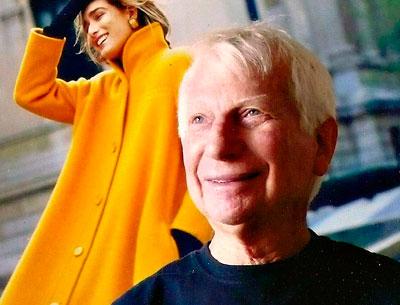Ilie Wacs, 86, Designer and Artist

Ilie Wacs, a celebrated coat designer and part-time Wainscott Main Street resident, died on Sept. 7 at home in Manhattan. The cause was cancer, his publicist, Susan Arpin, said. He was 86.
From the late 1960s to the 1980s, the women’s coats and suits he designed were frequently seen in The New York Times, Women’s Wear Daily, Vogue, Harper’s Bazaar, and other fashion magazines.
After closing his fashion firm in the early ’90s, Mr. Wacs became an artist, painting from his apartment overlooking Central Park in Manhattan or in Wainscott in the summers at a house he shared with his partner of 30 years, Susan Halpern.
He was born on Dec. 11, 1927, in Vienna, the only son of Moritz Wachs and the former Henia Fachs. His father, who was from Romania, was a tailor, and his mother was a milliner and former beauty queen from Poland.
At the age of 12, Ilie and his family fled Nazi-annexed Austria on the eve of World War II, finding passage on a ship to Japanese-occupied Shanghai, where Jews were accepted without restrictions. After World War II, the American Jewish Joint Distribution Committee helped Mr. Wacs win a scholarship to l’Ecole des Beaux Arts in Paris. He later transferred to the Acadamie Julian and then worked for Alex Maguy, a designer.
Mr. Wacs immigrated to the United States in 1942, joining his family in Manhattan. He worked as a sketch artist for Philip Mangone, a suit and coat maker, then as a designer at Seymour Fox, and later as the head designer for the coat maker Originala before producing suits and coats under his own label.
During a trip to the United States Holocaust Memorial Museum in Washington, D.C., on Mr. Wacs’s 70th birthday with his sister, Deborah Strobin, they discovered a photo of her posing for Japanese war propaganda as a young girl in Shanghai. As memories surfaced and the pair reminisced, a book project took shape, Ms. Arpin said. In 2011, they published a joint memoir, “An Uncommon Journey,” chronicling their escape from the Nazis, their time as refugees in the Shanghai Jewish ghetto, and their final arrival and rise to success in the U.S.
In recent years, the siblings shared their experiences with audiences at the 92nd Street YMHA, the U.S. Holocaust Memorial Museum, the Simon Wiesenthal Museum of Tolerance in Los Angeles and Manhattan, at various events sponsored by the American Jewish Joint Distribution Committee, and in schools. In 2013, they participated in Authors Night to benefit the East Hampton Library.
In November 2013, on the 75th anniversary of Kristallnacht, Mr. Wacs’s collection of artwork called “The Vienna Papers, 1938‚” was on display at Manhattan’s Simon Wiesenthal Museum of Tolerance. Debuting at the now-closed Pamela Williams Gallery in Amagansett in 2001, the collection was inspired by a suitcase stuffed with the family’s wartime documents, which he had inherited upon his mother’s death decades earlier. It was later left to the U.S. Holocaust Memorial Museum.
In his last year, Mr. Wacs continued a daily routine of jogging three miles around the reservoir in Central Park and playing tennis with a longtime group of friends until a week before his death.
His daughter, Maris Wacs of Hadlyme, Conn., described her father as “the perfect party guest because he was gregarious, handsome, smart, and funny.”
In addition to Ms. Strobin, Ms. Wacs, and Ms. Halpern, he is survived by another daughter, Darin Wacs of Montclair, N.J., five grandchildren, and Ms. Halpern’s daughters. His wife, the former Sylvia Silverstein, died in 1985.
Donations in Mr. Wacs’s memory have been suggested to the American Jewish Joint Distribution Committee at jdc.org.
